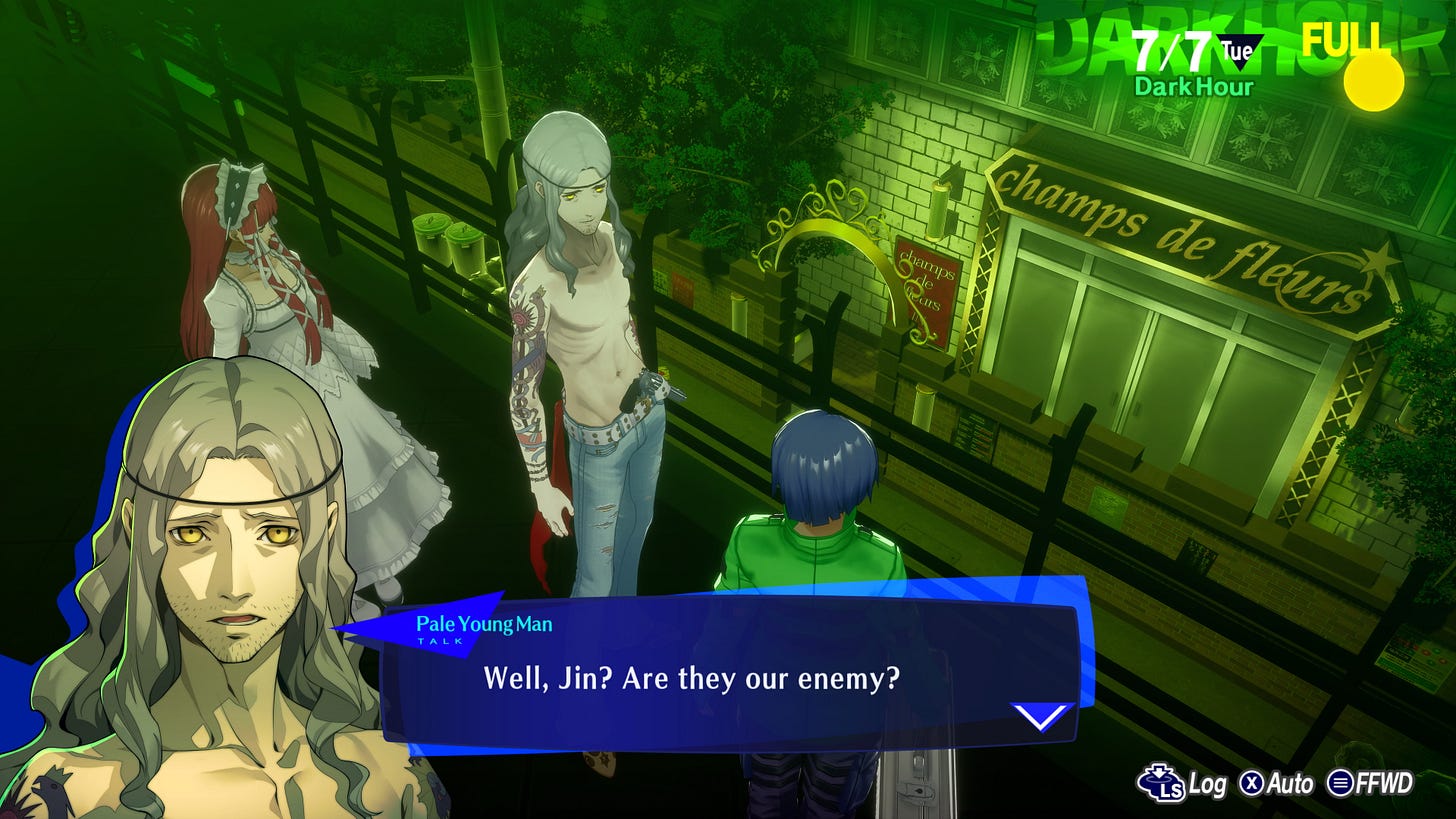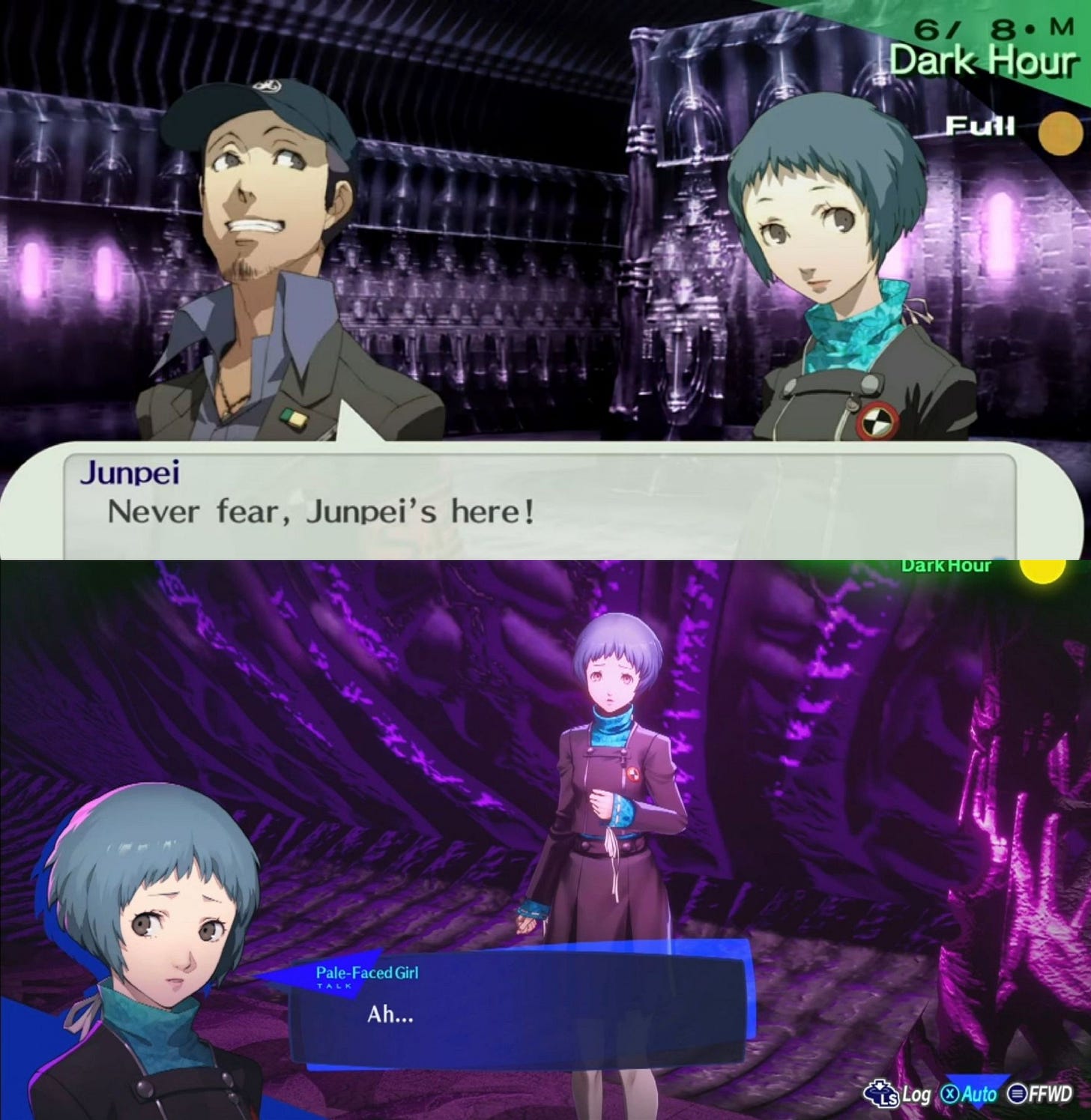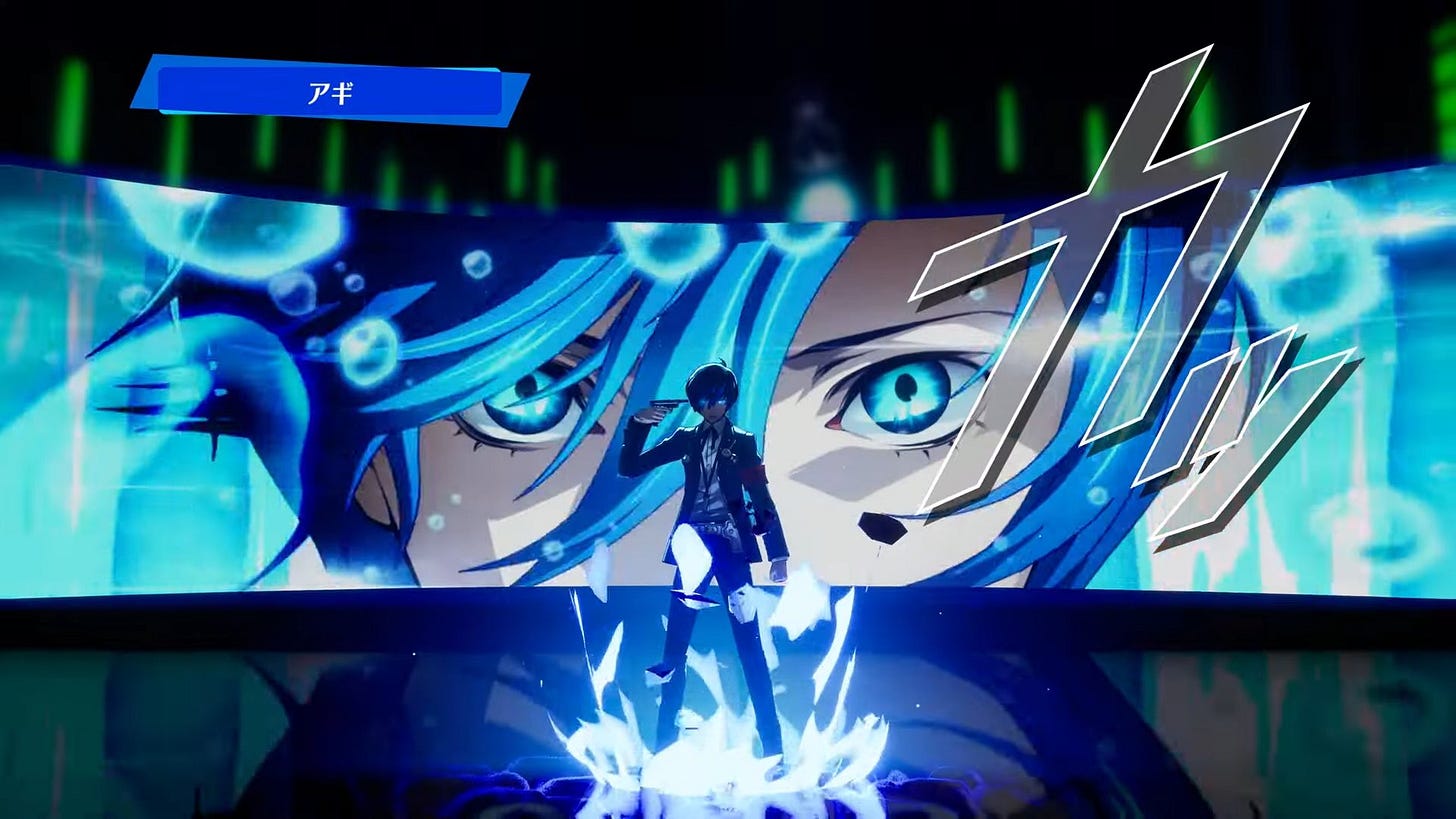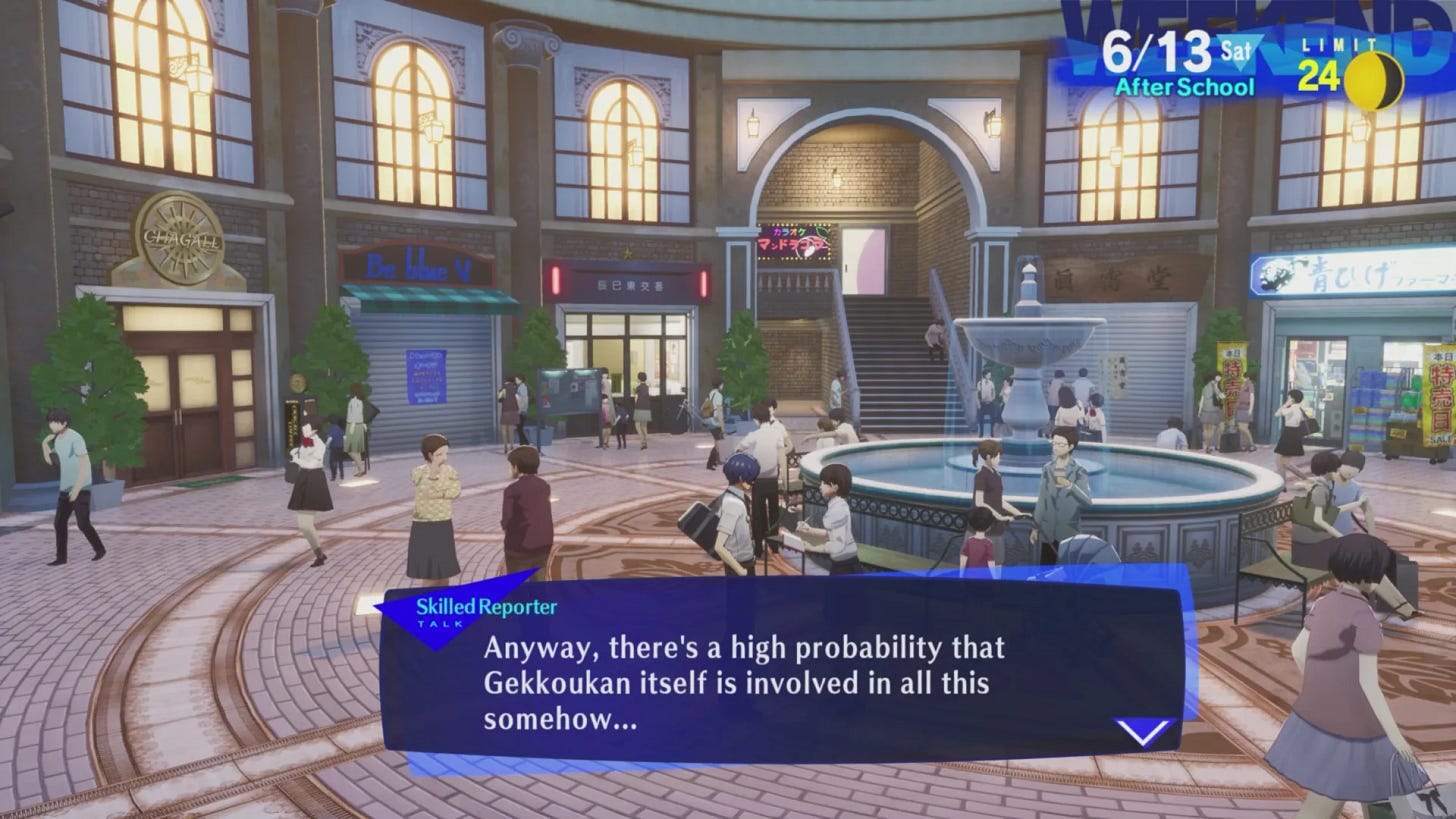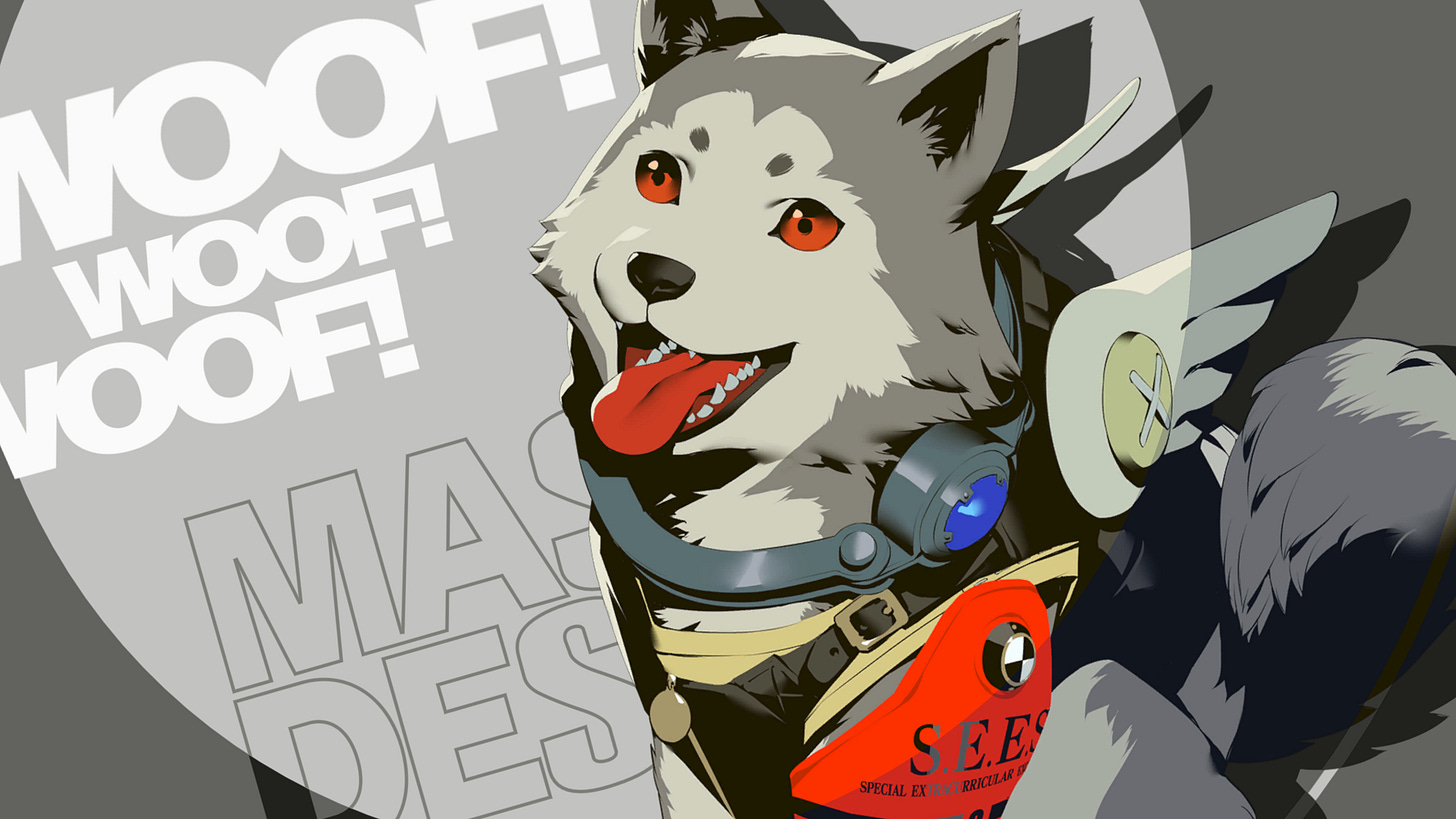Persona 3 Reload - Let's Talk Review
Is Persona 3 Reload worth your time? Or is it just one more in the recent trend of Remake duds?
So, let’s talk about Persona 3 Reload.
I have been playing Persona 3 Reload around the clock since it released, clocking in just over 300 hours into the game. I haven’t completed everything in the game, since I was short on maxing out one social link, and didn’t beat the secret super boss, but I beat the main story, completed almost all of the side content, and even checked out the bad ending for the hell of it. Trust me when I tell you I understand the game very, very well.
For those who don’t know, this is a remake of Persona 3, which has been remade and remastered more than a couple times in the form of FES and Portable. I personally played the Portable version originally made for the PSP (but recently rereleased for modern platforms), which featured an optional female protagonist. I purposefully played the female side of the story so I’d have a different take on the story and characters from what I would see in Reload. So, the male side of the side story was a new experience for me. And I’ll say, the female route has quite a lot of differences.
This review isn’t going to be an exhaustive list of every difference Reload has from every other version of Persona 3. If it was, we’d be here forever, and I think that kind of defeats the point of these Let’s Talk Reviews, which are intended to be more of a conversation between me and you about something worth talking about. I’ll, of course, be pointing out things I noticed, or substantive upgrades here and there. But, if you are looking for a kitty gritty, point by point changelog, that just isn’t going to happen here.
Story and Characters - 8
While there’s some issues with bringing some of the elements together in a more unified vision, the story and characters really shine here, as you would hope in a Persona Game
The main stage of any Persona game is its story and characters. Persona is a game about, well, the Persona. The writers for the game are certainly big on Jungian Psychology, and the different characters and story beats are explorations of these ideas. What makes us tick? What face do we show to the rest of the world? How do we fit into the greater tide of society? What do we struggle with?
Every Persona game has had a different overarching theme that plays out in different ways across the different characters. In Persona 4, the pursuit of Truth, and how the media shapes and is shaped by public perception were foundational to nearly every character conflict, with the flair of small country town blues. In Persona 5, it was Rebellion from the unjust constraints of society, allowing for the usurpation of the corrupt leaders holding onto the levers of power.
For Persona 3, the central theme is Death, or more specifically, the Death Drive, or Thanatos. This of course is a rather classic Freudian idea, but one that Jung engaged with also. Every character in the game either has had a death among their family or friends, has seen or is going through the death of a relationship, is allowing their self-destructive tendencies to rule them, or is literally dying themselves. Grief, despair, and regret are common in these stories.
Given the subject matter, the story can, at times, come off as overly dramatic, or edgy. However, I find that it definitely connected with me. Yukari’s story, in particular was pretty interesting to me, given the grief she feels for the loss of her father, and how guilty she feels about it given that he may just be why the entire conflict is happening in the first place. In many ways, her story, worries, and struggles hold the whole narrative together, especially in the first half of the game. There are some characters that you could take out, and the story wouldn’t suffer too badly. Yukari holds the emotional current, and really it’s only once Yukari has made a measure of peace with her past that the other characters really start to influence the story.
I won’t get too into depth here on story details, since I really think it is best experienced rather than explained in overview, and the hope with these reviews is that you give the game a try yourself. But I will say that the story here does a great job of keeping you guessing, without leaving you entirely in the dark. That can be really difficult to do, especially in a story laser focused on something like Death. There were some genuine surprises here in the story that the game does a great job of telegraphing just beneath the surface. This isn’t true for every surprise, or twist. I think pretty much anyone will be able to figure out who the new character introduced in the late second act of the story is pretty much immediately. But, even the blaringly obvious is usually handled in an unexpected way. That can be really difficult to do, so I have to give credit there.
Issues
I do have some nitpicks that bring the score down some, and many of these are more related to how these things were handled in the original game. So if you are already a fan of the game in spite of these, or recognize these more as constraints of the time, I totally understand. Remember these are nitpicks, not blanket condemnations or deal breakers, just things that kept this from being a flawless story experience for me.
The social link and side story beats feel very brief. Many of the social link scenes feel like they end right when they were getting started. This results in many of these coming off as more shallow, or by the numbers than what I’ve come to expect in Persona games given my experience in 4 and 5. This is a rather unfair comparison, given that 3 paved the road to the formula balance in 4, and then further elevation in 5, but it was nonetheless something that persistently gnawed at me throughout. This is more of a constraint of the time, in my opinion. Even links that have several of these shallow scenes do end up having deeper, more impactful beats along the storyline. This might even be a positive thing for players who are not as into the visual novel component of the game, and I can understand that, but I think it bears noting.
Some of the conversation choices that are optimal in terms of social link progression are… strange, to say the least. At one point a little kid is thinking about running away from home, and the option that is best is not discouraging it. Even in high school, I would have told the kid that running away from home was a bad idea, and I might have gone as far as trying to talk to the parents. It just really rubbed me the wrong way. There’s also a kid in track who has a leg injury that won’t heal, and he insists on running on it more. He has a motivation for doing so, but the best thing to do is to tell him he should keep running on it. Really? I get that some of this is saying what the character wants to hear or is emblematic of the character themselves, but I don’t think I’ve ever been so immature as to say “Yeah, sure, risk never being able to walk again.” Also, let’s just say Tomochika’s social link is just fucked. I could have done without it in it’s entirety. The whole time I wanted to grab him by the collar and tell him to wake the hell up.
Even though they play an interesting counterpoint to the game’s heroes, I felt like the anti hero team, Strega, was somewhat tacked on, and overstayed their welcome. I was waiting for the other shoe to drop that they were actually centrally instrumental in bringing about the primary conflict in the third act. But it just didn’t. After they supposedly were defeated in the second act, they just kind of linger to stir up trouble and spout fatalistic mumbo jumbo. I feel like they were almost unnecessary in the story, and somewhat unfocused the scope of the story. Maybe in a previous draft of the story they had a much bigger role. However, as is, I’m not sure I’d miss them if they weren’t in the story at all. This would actually clear the deck some for the midgame twist to develop more, allowing the inciting character to have a bit more presence. As it is, Strega kind of just steps over them for very little pay off.
As a final note, I’d like to complain just a bit about the bosses in the first half of the game. Something Persona 4 and 5 did a really great job of was to tie in the bosses of each dungeon in the central story in a meaningful way. They were victims, or perpetrators of the crimes that were shaping the main narrative. This is not so in Persona 3. And near the end of the first act, it started to get very stale. You are tasked with taking down big Shadows that represent the Major Arcana. That’s a neat idea, and I understand that it has some tangential relevance to the final boss fight. However, a tangential relationship, especially separated by an entire act of complicating plot, is almost pointless. Really, the first half of the game feels more video gamey than it does a natural flow of the story. Oh, it’s the end of the month, time for a boss fight.
The only motivation you have to beat the bosses is to not lose the game, and because you are told to. Don’t get me wrong, survival is a good motivator, but it doesn’t plug enough into the story to really sell how this will fit into a deeper story. I love the themes involved, how it revolves around phases of the moon and all, but it just feels unrelated to the rest of the game, which is so much more character-driven. I get that it is meant to build a story vector that gets twisted in the second act, but I would have really loved some more connective tissue to the rest of the story. Like what if they were failed experiments that lead to Strega (which would actually help to fix my issue with Strega), or, in a move not too dissimilar from Madoka Magica, these boss shadows were Persona users themselves, before losing control. Instead, they are just there.
All in all, in spite of these nitpicks, Persona 3 Reload’s story is a great time. I enjoyed it quite a bit myself.
Art Direction - 9
A fantastic revival of a classic, the art direction here is nearly perfect. Nearly.
Art
This might be the most controversial point of the review, but I absolutely loved the art direction in Persona 3 Reload. I think they struck a fantastic balance between using all the advancements in graphics, sound, and the vast canvas of possibilities that has opened up since the original, while honoring the original as much as possible. This game is drop dead gorgeous. Just walking around town is a fun experience that is even more immersive than Persona 5 is, I’d say. Light, in particular, really explodes off the screen, making some beautiful moments. The animation that plays for a critical or weakness hit is so, so satisfying, giving you a finely tuned dopamine hit for the eyes, as well as the mind.
The refreshed character designs are just impeccable, while clearly and definitively honoring the original designs. It also helps to bring them all together in a cohesive unit. This is pretty great since many of the character illustrations in the original could feel a bit off. Aigis definitely didn’t quite feel like her art was from the same game as the others, and the same is true for the female MC exclusive Rio in Portable. Even Fuuka felt a bit like she was from a different game than, say, Mitsuru and Yukari.
Their 3d avatars really help to bring them to life like they do in 4 and 5. Though this doesn’t just feel like a straight flip from Persona 5, there’s a couple of character models for random npcs that will look quite familiar. I actually recognized one of the student has the same face as the Host Boyfriend that Makoto’s friend has. I’m sure they are redressed asset flips, which I wouldn’t say is necessarily a bad thing. It is not like they, say, took Ann and just dressed her up with a different hair style and call her Mitsuru or something. The main cast is definitely bespoke and their models are quite expressive.
Something that is, both thankfully and sadly, gone is equipment changing the characters appearance, aside from their weapon or outfits. This a clear platform to allow the sale of cosmetics, like different looks for the various characters. However, I kind of liked how some armors would affect the character’s appearance. What is nice is you aren’t stuck looking at some of the more… embarrassing armors for certain characters. Or, if you want all the characters parading around in their swimsuits in Tartarus, well, you can do that now.
Sound
The sound design is just in top form here. The sound effects have more punch. The music is clearer and better balanced, and the voice cast does a great job of giving their characters voice. There’s only a couple of performances I wasn’t crazy about, but that was more because I thought another voice might have fit the character better. Takaya’s voice felt perhaps the most out of place to me. I felt like a deeper, more punkish voice, like the English voice for Tatsu in Way of the Househusband would have worked better for his look and personality. I think Jonah Scott would have killed it with the character. But, I think that’s more of a difference of opinion than anything.
On the note of voice acting, I gotta give a shout out to Shelby Young’s performance as Yuko. I wasn’t completely sold on the voice initially for the character, but she really sold it with all the personality she brought to the role. You can tell she really had quite a bit of fun with it. Heather Gonzalez also turned in a wonderful performance as Yukari. It had to be a very challenging role to get right since she has so much going on in her story. It would have been so easy to make her sound bitchy, or whiny, even overly dramatic. Somehow she threads the needle, and really nailed her character.
Gameplay - 9.5
Fun, Satisfying, and steeped with tools to deepen player efficacy. Just short of perfect, though.
But hey, it’s not all story all the time. You gotta kick a lot of ass to get through the storyline, and kick a lot of ass is exactly what you will do. The new and rebalanced mechanics really make this a title you’ll be scrambling to turn on when you get home. They could have easily just taken the system from Persona 5 and dropped it in here and called it a day. I think a lot of people probably would have been OK with that. Instead, just like the entire game, you get substance of the Old, with the fit and finish of the New, along with some great quality of life tweaks.
Weapon attacks are still separated into Slash, Bash, and Pierce like 3 was. All the same elements are on display too, and the progression of unlocking skills and powers feels very much like the original. I’m not 100% sure, but it seems like they revamped the Persona fusion table a bit, which I think is always welcome for Persona players. I liked how they redid how the Antique shop to get those special weapons. It was nice chasing down some of the special materials to get, say, a super busted gun for Aigis that ignores resistances, as opposed to just crunching an op Persona, and summoning it again. The extra avenues to get different skills on persona, or buff them with incense was nice too. I just wish you could use Skill Cards on your companions’ Persona, even if the list was quite limited for each. I’d have loved to change up their move sets a bit more. I hate that I couldn’t get Yukari Panta Rhei, for example. It isn’t a dealbreaker, but something that left me a bit disappointed.
One interesting add here are “Link Episodes.” These are a kind of quasi Social Links that give story beats to some of the main cast who don’t get Social Links, or give you a glimpse into a character’s more mundane life side. What kind of TV do they like to watch? What would they cook? What do they like to read? How many punks can Akihiko beat up? Stuff like this is fascinating on its own, but many of these also lead to new abilities for the characters, like cutting the cost of healing spells for Yukari, or boosting the chances of causing an ailment, so on and so forth. I really like that. I wish they were tied to the social links, like in 4 Golden and 5 Royal, but I appreciate a different take that in turn fleshes the characters as normal people we can relate to.
Elizabeth’s requests are still here, with some pretty great rewards too, and helpfully give you a marker to help point you in the right direction for a request. It is rare that you’ll need to, say, look up what night you can ask Akihiko for protein powder, or something like that. That’s not to say that some of them are not difficult to do, or do not involve some work to resolve. It’s just nice to have a little bit of a direction for some of these to keep your mind more in the game, rather than a guide.
Same thing with the Social Links. The game makes it very easy to see who is available, and even if there’s someone you haven’t started with yet. Usually there is some kind of scene in the transitions that will highlight something, like a new character, or new items in stock at the stores. It's these little nudges that really make the experience more enjoyable to negotiate, as opposed to the near impenetrable calendar obsession-driven madness that games before 5 devolved into. The fact that I got all but one social link maxed out on my first run through the game, without making a conspiracy theory level chart and calendar to figure out when to do what should tell you how much better the flow is here. That’s good stuff. Mystery and hidden things in these games is great, but you can still do that while at least giving people a nod in the right direction. That is what Reload really succeeds at, and could be one of it’s greatest achievements.
And that’s really the thing here. The Persona games already come out of the box with a 7/10 gameplay loop. It’s the little touches and tweaks to enhance player efficacy, and reward exploration and hard work, that makes all the difference.
Value for Money - 10
Your mileage may vary, but this is a lot of game for the price tag.
So, this is a $70 game, a price bump from the established $60 I still fundamentally disagree with, especially given that there’s paid DLC and cosmetics for this. The question always is with Remakes and Remasters is if enough is done to justify the full price, or if a lower base price would make more sense. I think enough has been done here to more than justify full price. No aspect of this game has been left untouched in a meaningful way. The Art Direction and Gameplay components alone make this worth it.
However, this is also on Game Pass, and they are even throwing in the Episode Aigis DLC. That’s pretty freaking dope if you ask me. If you are already on Game Pass, you get a whole lot of game for very little in the way of dough.
That’s what really informs the score here is how much game you get here. I squeezed 300 hours out of this, and still had some stuff I wanted to do. Hell, I’m contemplating a New Game Plus run. If you can get even a quarter of that runtime out of a game, even at the inflated $70 price point. I think you have a pretty great deal on your hands. Your mileage may vary, and you may have different math for this, but that’s how I factored the score here.
Personal Enjoyment - 10
300 hours in, and the game never got old for me. Seems like a winner to me.
I really enjoyed this game. It isn’t my favorite Persona game, that crown I think still goes to Persona 5 Royal. It’s narrative is so much more laser focused on its theme, and I think really negotiates it fantastically well. Persona 3 Reload is hitting much harder for me than Portable did, and I’d say it definitely kicked Persona 4 Golden from #2.
It's the little things that really add up here. The gorgeous art direction, the tweaks to gameplay, and how it all fits together into delivering better on its story and characters just makes for a fantastic experience that I kept coming back to again and again. While I’m pretty satisfied with my playthrough, I do find myself thinking about a New Game Plus run, and there’s only a few games I’ve seriously considered that for that are anywhere close to that long, Persona 5 being one of them.
A quick note on the cut content. When I started this game, I played it with the mindset of seeing it as it’s own thing, not necessarily a remake. But, I was interested to see if a
Overall 9.3
Story and Characters 8
Art Direction 9
Gameplay 9.5
Value for Money 10
Personal Enjoyment 10
If you’ve never played Persona 3, a Persona game period, or even if you did play one of, if not all of the different iterations of Persona 3 over the years, I think there’s a lot here for you. It is incredibly new player friendly, without being simplistic or lacking mystery. It has a story worth experiencing, especially for how it influenced what came after. The revamped art and gameplay are worth the price of admission alone, especially if you have Game Pass. This game is such a great time. I haven’t even talked about all the new things they added or tweaked, as I’d rather there be some surprises for if you decide to pick the game up. For newcomers to the series, if you love RPGs that break the mold a bit, with deep mechanics, and character-driven stories, this is a great place to start!
I had a great time with Persona 3 Reload, and I think you will too.
I hope that you have enjoyed this Let's Talk Review! Every now and then I play or watch something I feel like sharing my impressions on, and that's what this is all about. While there are scores and numbers here, this is more of an earnest, informal discussion of my impressions on a subject. The scores here are merely here to give an at-a-glance metric of my thoughts.
Let me know what you think! I'd love to hear your take if you played the game, or answer any questions you might have. Please share it on social media, drop a like, or a comment down below, if you enjoyed the review, and would like to see more!





